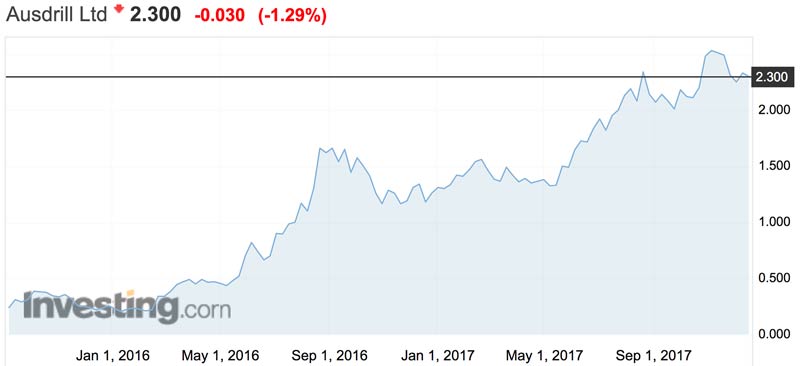Return of the pickaxe sellers: Ausdrill’s 1000% turnaround
Mining
Mining
In all mining booms it is the “pickaxe” sellers who do best, an old term that refers to companies selling services and essential supplies. There is no better example in today’s mining revival than Ausdrill and its 1000% share price rise over the past two years.
A specialist drilling rig operator with crews and equipment scattered across Australia and overseas, especially West Africa, Ausdrill’s share price rise from a low of 21c in early 2016 to recent trades at $2.33 (and a high last month of $2.64) tells a story of a remarkable recovery from tough times.

Grubstaking
But the Ausdrill (ASX:ASL) revival has two other features, one of particular importance for investors and the other of how Ausdrill reinvented one of the oldest exploration funding tools: grubstaking.
In the depths of the downturn, when exploration companies lacked cash and Ausdrill had idle rigs, a series of deals were struck in which the rigs returned to work with payment in the form of shares in the explorer, or a mix of shares and cash.
It was those deals which formed part of Ausdrill’s revival plan, and while some are still being written, including a $1 million “drilling for equity arrangement” last month with Golden Rim Resources, they have become a minor part of the drilling company’s business.
The more important aspect of Ausdrill’s resurgence, which included a 53% increase in profit last financial year to $18.4 million, is that more exploration drilling (the first and most basic step in mine development) means the selling of more services of every type, from earthmoving equipment to civil engineering.
Lucky Seven
In some cases, the “cat” is already out of the bag, a point that is certainly true in the case of Seven Group, the media to industrial equipment business controlled by Kerry Stokes with industry-leading Caterpillar earthmovers a key part of many mining projects.
Over the past two years, almost in perfect harmony with Ausdrill, Seven’s share price has risen by 220% to recent trades at $13.80, and while the share price might be close to a peak, that’s not stopping big investment banks such as Goldman Sachs recommending Seven as a buy, partly because of the mining recovery and partly because of increasing levels of infrastructure spending.
In a note to clients late last month Goldman Sachs noted how the “mining backdrop (was) set to improve” as miners return to normalized equipment orders, a much-needed boost to all “pickaxe sellers” because in Seven’s case new equipment sales by its WesTrac equipment business last financial year were down 80% on the peak year of 2013.
Mining service stocks
There is an investment theme running through Ausdrill, Seven, and a number of other mining service related companies such as Monadelphous (an engineering firm specializing in the resources sector) which has seen its share price rise by 200% over the past two years.
It might be easy for an investor to assume that the best of the recovery, and future profits, are already reflected in the share prices of the pickax sellers.
In some cases, that’s probably true but it was significant to read recently that Alex Waislitz, the chairman of the very successful Thorney Investment Group sees mining service stocks as his next big target.
After a prosperous year from exposure to technology stocks Waislitz told the Australian Financial Review newspaper that he was keen on mining services stocks.
“The sector has been capital-starved for five years, maybe seven years,” he said. “What has happened is the wear and tear on equipment has been dramatic.
“The big miners and some of the smaller ones are still producing big tonnage, so you can only patch these things for so long. You have to reinvest in equipment and that is exactly what’s happening and there are new projects coming on as well.”
Pickaxe revival
Waislitz’s comments are correct as far as equipment goes, but they can be expanded to include the even more important question of discovering new orebodies, and that’s when drilling companies such as Ausdrill come into consideration.
Not widely researched by the big investment banks Ausdrill was the recipient of a buy tip from Deutsche Bank in October thanks to its promising profit outlook which is underpinned by work in West Africa and at sites across Australia.
For investors who missed the first flush of the mining services industry revival the trick now is to watch for profit flows in 2018 which should accelerate a sector-wide uplift, from drilling contractors to equipment retailers and engineers.
Percentage share-price rises will not be as spectacular as the past two years, but the profits being earned will flow into dividends and that could trigger a second flush of the pickaxe revival.
Tim Treadgold’s The Explorer column appears weekly in Stockhead.
Tim is a Perth-based finance journalist who has been covering the resources sector for more than 40 years for national and international publications, long enough to know what’s gold and what’s fool’s gold — of which there’s quite a bit in the mining world.
This article does not constitute financial product advice. You should consider obtaining independent advice before making any financial decisions.